| This page in the original is blank. |
Role of Simulation in the Design of Next-Generation Engines for Military Aircraft
Mark N. Glauser
Department of Mechanical and Aeronautical Engineering Clarkson University Potsdam, New York
To stimulate and enable the emergence of new concepts for affordable advanced flight vehicles and propulsion systems, fast, adequate, and affordable models are necessary to support computational fluid dynamics (CFD)-based design in realistic complex flows. Complex turbomachinary flows, such as those used in current and future military aircraft engines, exhibit unsteady aerodynamics, forced blade response and high-cycle fatigue, complex confluent interacting flows with strong rotation, compressor surge and stall instabilities, and losses and extremely high temperatures in both the combustor and turbine components. In addition to the complexity of the systems themselves, the flows exiting these propulsion systems are complex three-dimensional shear flows characterized by large temperature, velocity, and density fluctuations. Such exit flows can be detrimental to other components of the aircraft such as control surfaces like flaps because of extremely high heat loading. They also impact the acoustic and thermal signatures of the flight vehicle. In this paper, a brief overview of current uses of CFD methods will be presented and elucidated by example. We will begin at the compressor, skip the combustor for now (we will discuss an exciting very recent development for simulating combustor flows later), move to the turbine, and finally discuss applications to exit flows. Problem areas as well as successes will be noted and future directions discussed.
Currently, CFD tools, as well as various experimental methods such as laser Doppler anemometry and particle image velocimetry, are being used by William W. Copenhaver at Wright Patterson Air Force Base to focus on the influence of stator wakes on transonic stage performance in compressors. Copenhaver (1998) is attempting to identify the influences that upstream wakes have on transonic blade row aerodynamic and aeromechanical responses. The simulations are
based on APNASA, which is a National Aeronautics and Space Administration Lewis steady-state code with k-epsilon turbulence model. The wake information computed from the APNASA code is substantially different from experimental results at this point. The key problems with the simulations are the lack of inclusion of the unsteady nature of the flow and the inadequate turbulence model.
Richard Rivir, also of Wright Patterson Air Force Base, is focusing on the prediction of unsteady heat transfer at the leading edge of the high-pressure turbine to assess leading-edge cooling methods. Rivir (1998) is using an unsteady Navier Stokes code with limited success, sometimes having as much as a two to one variation between simulation and experiment. Clearly, more physics must be built into such simulations, in particular to properly account for turbulence.
A very exciting application that impacts the exit flow involves the use of CFD, coupled with careful analysis and experiment, to guide the development of active flow control of the hot jet plume for the reduction of the C- 17 flap temperature. Currently, the hot plume impingement necessitates titanium plates on the C-17 flap system and susceptibility to infrared threat. CFD results have been used to guide the development of active control strategies for reduction of the plume temperature through enhanced mixing. This effort, termed active core exhaust control, has transitioned to a full-scale engine test. Results from the full-scale test have shown the feasibility of mixing out the plume so that by 10 diameters downstream the peak temperature has been reduced by a factor of two. The CFD played a key role in parameter space surveys, providing guidance on optimum injection flow rate and optimum injection frequency as well as placement of injectors.
As the above examples show, simulations play an increasingly important role in design methodologies for complex turbomachinary flows, although much fundamental work is still required to improve existing simulation tools. We can categorize the simulations of flows as follows. The direct numerical simulation (DNS) of turbulent flows involves solving the full Navier Stokes equations, resolved to all scales (Moin and Mahesh, 1998). DNS provides a powerful tool for model development and fundamental physical insight into flow physics, although it is limited to relatively low Reynolds numbers and simple geometries. Large eddy simulations (LESs) resolve the larger scales in the flow, and the smaller scales (subgrid scale) are modeled (Lesieur and Métais, 1996). Currently, LES applications have been limited to relatively simple geometries but at somewhat higher Reynolds numbers than DNS. Recently much progress has been made in applying LES to more complex flows, and an application to gas turbine combustors will be discussed below. Reynolds Averaged Navier Stokes (RANS) and unsteady RANS (called by some "very large eddy simulations") are the current workhorses in industry (Speziale, 1991). These methods involve solving evolution equations for the mean flow as well as various levels of the turbulent statistics. Finally, new methods, termed low-dimensional modeling (LDM), are being explored to help in the guidance and implementation of active flow control
strategies (Lumley and Blossey, 1998). The philosophy of LDM is to develop very simple physics-based simulation models that contain sufficient information for implementing flow control and insight into the dynamics of the large eddies (coherent structures). Except for DNS, some form of modeling is required for all of the above.
In terms of future directions for simulation of complex flows, for turbulence modeling, unsteady effects must be included as well as some component of the turbulent structure. One example of an approach to include structure involves including the structure of the turbulence in single-point turbulence models (Reynolds and Kassinos, 1995). The structure of turbulence often plays a key role in the transport of turbulence stresses. The absence of this type of information from practically all currently used one-point turbulence models (Reynolds stress transport and eddy viscosity) limits their performance. The structure-based model of Reynolds and Kassinos (1995) is now approaching a level of maturity that will allow testing in more realistic complex flows. For implementation of LESs in practical flows, methods must be developed to deal with complicated boundary conditions and improve subgrid-scale modeling. As an example, Pierce and Moin (1998) have developed an LES-based prediction method for combustor flows with swirl. The effects of swirl are cleverly added by imposing a body force via swirling inflow conditions, resulting in a practical LES tool for studying realistic combustor flows. Finally, for implementation of low-dimensional models in practical flows, methods must be developed to deal with complicated boundary conditions and improve subgrid-scale modeling. A key need is to extend such models to flows with separation since their control is a focus of much current interest.
References
Copenhaver, W. 1998. Turbomachinary fluid mechanics. Pp. 79-81 in Proceedings of the Aerodynamics and Turbulence Conference. Washington, D.C.: Air Force Office of Scientific Research.
Lesieur, M., and O. Métais. 1996. New trends in large-eddy simulations of turbulence. Annual Review of Fluid Mechanics 28:4845-4882.
Lumley, J. L., and P. Blossey. 1998. Control of turbulence. Annual Review of Fluid Mechanics 30:311-327.
Moin, P., and K. Mahesh. 1998. Direct numerical simulation: A tool in turbulence research. Annual Review of Fluid Mechanics 30:539-578.
Pierce, C. D., and P. Moin. 1998. Method for generating equilibrium swirling inflow conditions. AIAA Journal 36(7): 1325-1327.
Reynolds, W. C., and S. C. Kassinos. 1995. One-point modeling of rapidly deformed homogeneous turbulence. Proceedings of the Royal Society of London A 451:87-104.
Rivir, R. B. 1998. Turbine aerothermal research at the Air Force Research Laboratory. Pp. 345-347 in Proceedings of the Aerodynamics and Turbulence Conference. Washington, D.C.: Air Force Office of Scientific Research.
Speziale. C. G. 1991. Analytical methods for the development of Reynolds-stress closures in turbulence. Annual Review of Fluid Mechanics 23:107-157.
Role of Simulation in Understanding Surface Roughness in Formed Aluminum Parts
Armand J. Beaudoin
Department of Mechanical and Industrial Engineering University of Illinois at Urbana-Champaign Urbana, Illinois
Introduction
One does not have to look far to observe metals as an engineering material with widespread application. Metals offer the designer a class of materials with a broad range of behaviors. Further, metals are accompanied by a long history of experimental characterization and continuous refinement of techniques for analysis. The ability to describe metal deformation is critical to both the design and the manufacture of metal products. Accurate analysis is realized through the wedding of three engineering disciplines: materials science, mechanical engineering, and computer science. It is the intent of this paper to demonstrate how fruits from these branches of engineering science may be brought together to reveal insight into fundamental aspects of metal deformation—on a scale that bears relevance to industrial application.
In the following, a general framework that incorporates a detailed and physically based material description—crystal plasticity—into finite element procedures is outlined. The success of crystal plasticity theory in predicting behavior in metal forming is built on several things: initialization of a mathematical description for a complex microstructure using experimental data, effective use of computational resources, and visualization of results in a manner that reflects experiment. It is argued that such detail offers both improved predictive capability and effective utilization of computing resources. In closing it is proposed that continued development of physically motivated models will enable the simulation of more general thermomechanical processes for metal production.
Approach
Metals are composed of crystals (see Figure 1). Taken individually, the crystals are anisotropic. That is to say that their properties are dependent on the direction; the yielding of a crystal depends on the orientation of the applied load. Typically, a metal product intended for an engineering application is a "bulk" material—there are lots of crystals. Provided a material point1 in the bulk workpiece contains a sufficient number of crystals, the properties of that point may be treated as a polycrystal (Kocks, 1970). The distribution of crystal orientations in the polycrystal is commonly referred to as the texture. Because the distribution is rarely a random one, the texture contains preferred orientations and thus imparts directional properties to the polycrystal.
The field of materials science provides a wealth of theory for describing the deformation response at the scale of the crystal (Bishop and Hill, 1951; Taylor, 1938) and collecting the responses of underlying crystals to model the plasticity of the polycrystal. Accompanying the development of theory are allied experi-
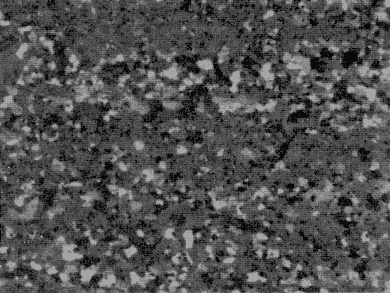
Figure 1
Metal microstructure composed of crystals. Source: Reprinted with permission from The Minerals, Metals and Materials Society and ASM International (Beaudoin et al., 1998).
mental techniques for measuring the texture of a metal. The distribution of normal vectors to crystal planes may be collected using x-ray diffraction. The techniques of quantitative texture analysis enable the development of distribution functions for crystal orientation from the x-ray data. As the name suggests, the result is a quantitative description of the texture. Alternatively, backscatter Kikuchi diffraction (BKD) patterns may be collected through electron microscopy (Adams et al., 1993; Wright and Adams, 1992). This technique provides not only the crystallographic orientation but also the spatial location of the orientation measurement. As will be pointed out below, parallel computation enables the treatment of large datasets generated through material characterization. The combination of experimental methodology and crystal plasticity theory provide for both the initialization and evolution of texture in a computer simulation.
At the heart of finite element methods is the capability to treat inhomogeneity in the field variables of interest. With regard to plastic deformation of metals, these variables are forces and displacements. The finite element formulation may be melded with the constitutive description provided by crystal plasticity theory described above. In this way, deformation of workpieces may be examined with gradients in the field variables accommodated through finite elements and concomitant response at material points within elements achieved through the crystal plasticity description. In general, there are two approaches to combining finite elements with crystal plasticity theory. A polycrystal may be contained within each finite element (see Figure 2), or a finite element mesh may be used to discretize a polycrystal (see Figure 3).
For the analysis of a bulk processing operation, an aggregate of crystals is
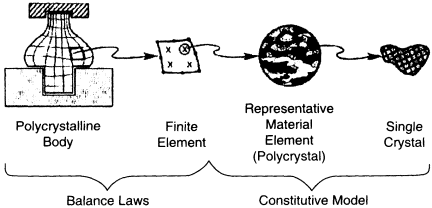
Figure 2
Finite element analysis of bulk forming operation. Source: Reprinted with permission from Cambridge University Press (Kocks et al., 1998).
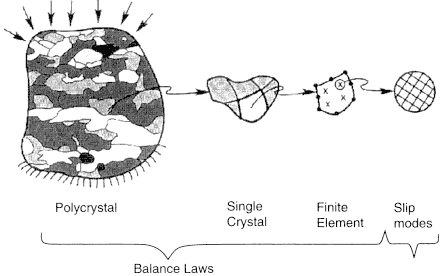
Figure 3
Finite element analysis of metal microstructure. Source: Reprinted with permission from Cambridge University Press (Kocks et al., 1998).
placed at integration points within the finite element. The element response follows from the aggregate response of a contained polycrystal. The spatial dimension of a finite element should be orders of magnitude larger than the respective dimension of an individual (representative) crystal (Figure 2). Within the aggregate each crystal deforms in accordance with the deformation of the overlying finite element. This approach is useful for treating deformation inhomogeneity that arises from interaction between boundary conditions (typically owing to frictional contact between the metal workpiece and the tooling) and overall material anisotropy. Examples of operations that have been treated by using this approach are drawing (Balasubramanian and Anand, 1996; Smelser and Becker, 1991), rolling (Mathur and Dawson, 1989), hydroforming (Beaudoin et al., 1994), and autobody sheet forming (Bryant et al., 1994). The deformed shape of the workpiece arising from the simulation may differ significantly from that derived using isotropic material properties—a situation more in line with industrial practice.
Finite elements may also be applied to examine the deformations within a polycrystal. The emphasis is on inhomogeneities that arise from interactions between crystals. The dimension of a finite element is typically orders of magnitude less than the polycrystal, and boundary conditions are constructed to render a homogeneous deformation (Figure 3); that is, the entire finite element mesh
represents a material point. In contrast to the polycrystal fully contained within a single element, crystals gain additional degrees of freedom and conform with neighbors both in the sense of equilibrium and compatible deformation. This technique has been used to study grain interactions, origin of recrystallization nuclei (Beaudoin et al., 1996), and surface roughening (Becker, 1998). Such simulations provide considerable insight into the metal physics.
Application
Surface roughening developed during sheet forming operations may take a variety of forms. If the roughening has a random character, the surface may develop the character of an orange peel. Another possibility is that the roughness may take on a more directional character, with striations aligned in one direction. This defect is referred to as "ridging" or "roping" and is observed in aluminum alloys and ferritic stainless steels. Collectively, the ridges impart a corrugated pattern to the part surface. Alignment of the ridges is generally in the direction of prior manufacturing operations for rolling of the sheet. Such an effect is undesirable from the standpoint of visual appearance. In severe manifestations of the defect, grooves that formed between ridges act to limit formability of the product.
An idealized model was developed to study potential surface deformations arising from bands of grains with a similar crystallographic orientation. Automated collection of BKD measurements from samples of aluminum sheet was carried out by using the orientation imaging technique mentioned above. A mesh was formed by using 14,640 eight-node bricks, and a crystal orientation was assigned based on the BKD data. The surface deformation predicted for forming in biaxial stretch is shown in Figure 4. For plotting purposes the coordinate normal to the sheet was magnified so as to emphasize the roughening tendency. Shading is used to indicate orientations of crystals forming the microstructure. The cube orientation, generally associated with recrystallization following thermal treatment, is shaded in dark gray. Crystallographic orientations that have origins in the cold working of face-centered cubic metals (labeled S, Cu, and Br as a matter of historical convention) are marked with lighter shades of gray. In general, the cube grains tend to yield regions of greater thinning, forming a groove. Adjacent to the band of cube orientations is a ridge lying along the midline of the mesh.
Future Directions
The strength of crystal plasticity in describing deformation is founded principally on the ability of the theory to detail the average behavior within a crystal. Indeed, it is this average response that dictates behavior in deformation. Yet in many manufacturing processes deformation is closely allied with thermal treat-
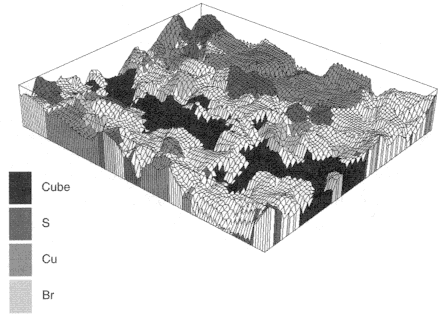
Figure 4
Simulation of surface roughening. Source: Reprinted with permission from The Minerals, Metals and Materials Society and ASM International (Beaudoin et al., 1998).
ment. Thermomechanical processing elicits the nucleation and growth of crystals within a microstructure, often dramatically changing the metal anisotropy. This nucleation and growth process is dependent on what happens "at the edges" (Doherty et al., 1997); in these processes the tails of the orientation distribution may bear more influence than the mean. The development of substructure in polycrystals and the origins of recrystallization are active areas of research that will lead to a more complete description of metal behavior. As an example, while present technologies reveal insight into the mechanisms of surface roughening (as presented herein), the correction of the defect through hot rolling and heat treatment is not—at present—a tractable problem for simulation.
The results presented follow from theory that has been developed since the early 1900s. The success of the crystal plasticity approach follows from maintaining fidelity in the description of metal physics at the expense of detail. However, parallel computation and sophisticated numerical methods are available, and the approach outlined herein provides opportunity for leveraging such resources. The challenge lies in continued development of physically motivated, quantitative descriptions of metal behavior. The extension to more general
thermomechanical processing mandates the development of accurate models with variables of state that are initializable and may be evolved to characterize properties. The continuous improvement of existing production processes and the development of novel processes will be enhanced by ongoing development of theories for metal behavior.
References
Adams, B. L., S. I. Wright, and K. Kunze. 1993. Orientation imaging: The emergence of a new microscopy. Metallurgical Transactions A 24A(4):819-831.
Balasubramanian, S., and L. Anand. 1996. Single crystal and polycrystal elasto-viscoplasticity: Application to earing in cup drawing of F.C.C. Materials. Computational Mechanics 17(4):209-225.
Beaudoin, A. J., P. R. Dawson, K. K. Mathur, U. F. Kocks, and D. A. Korzekwa. 1994. Application of polycrystal plasticity to sheet forming. Computer Methods in Applied Mechanics and Engineering 117(1-2):49-70.
Beaudoin, A. J., H. Mecking, and U. F. Kocks. 1996. Development of localized orientation gradients in FCC polycrystals. Philosophical Magazine A 73(6):1503-1517.
Beaudoin, A. J., J. D. Bryant, and D. A. Korzekwa. 1998. Analysis of ridging in aluminum auto body sheet metal. Metallurgical and Materials Transactions A 29A(9):2323-2331.
Becker, R. 1998. Effects of strain localization on surface roughening during sheet forming. Acta Materialia 46(4): 1385-1401.
Bryant, J. D., A. J. Beaudoin, and R. T. VanDyke. 1994. The effect of crystallographic texture on the formability of AA 2036 autobody sheet. SAE Transactions Sect. 5 103:49-57.
Bishop, J. F. W., and R. Hill. 1951. A theory of the plastic distortion of a polycrystalline aggregate under combined stresses. Philosophical Magazine 42:414-427.
Doherty, R. D., D. A. Hughes, F. J. Humphreys, J. J. Jonas, D. Juul-Jensen, M. E. Kassner, W. E. King, T. R. McNelley, H. J. McQueen, and A. D. Rollett. 1997. Current issues in recrystallization: A review. Materials Science and Engineering A238(2):219-274.
Kocks, U. F. 1970. The relation between polycrystal deformation and single crystal deformation. Metallurgical Transactions 1(5): 1121-1143.
Kocks, U. F., C. N. Tome, and H.-R. Wenk, eds. 1998. Texture and Anisotropy: Preferred Orientations in Polycrystals and Their Effect on Materials Properties. Cambridge: Cambridge University Press.
Mathur, K. K., and P. R. Dawson. 1989. On modeling the development of crystallographic texture in bulk forming processes. International Journal of Plasticity 5(1):67-94.
Taylor, G. I. 1938. Plastic strain in metals. Journal of the Institute of Metals 62:307-324.
Smelser, R. E., and R. Becker. 1991. Earing in Cup Drawing of a(100) Single Crystal. Pp. 457-471 in ABAQUS User's Conference Proceedings. Providence, R. I.: Hibbitt, Karlsson & Sorensen.
Wright, S. I., and B. L. Adams. 1992. Automatic analysis of electron backscatter diffraction patterns. Metallurgical Transactions A 23A(3):759-767.
Machine Performance Assessment Methodology and Advanced Service Technologies
Jay Lee
United Technologies Research Center East Hartford, Connecticut
Abstract
This paper introduces an assessment methodology for machine performance degradation through correlated neural behavior reasoning. This methodology provides a behavior-based model for machine performance monitoring and failure prevention. In addition, research challenges and opportunities in digital service technology for the life-cycle support of products and engineering systems in a global enterprise are introduced.
Introduction
Today's industries are facing serious structural problems brought about by their rapid development of overseas activities within a globally integrated manufacturing enterprise. Service and maintenance are becoming extremely important for companies to maintain their manufacturing productivity and customers' satisfaction in foreign regions. The recent rush to integrate highly sophisticated manufacturing equipment with locally supported design and manufacturing engineering practices has further increased the use of relatively unknown and untested technologies. Frequent breakdowns of machinery have been a serious concern. Difficulty in identifying the causes of system failures has been attributed to several factors, including system complexity, uncertainties, and lack of adequate troubleshooting tools (National Research Council, 1995). A new paradigm should focus on quality of service in the products we design and manufacture. Factories in different regions need to be coordinated through use of state-of-the-art information technologies to ensure consistent manufacturing and product quality. For example, the performance of a machine could be monitored
and assessed from anywhere in the world. In addition, information on productivity, diagnostics, and service evaluation of manufacturing systems could be shared among different locations and partners.
Digital service technology is an emerging field that addresses service issues for manufacturers and customers. With growing manufacturing globalization activities, companies are looking for ways to assess the performance of their manufacturing operations and products in remote sites. Digital maintenance diagnostics and maintenance tools such as "watchdog"-type information mechatronics with integrated media will improve the effectiveness of maintenance activities (Goncharenko et al., 1997; Lee, 1992, 1995a,b, 1996c; Lee and Kramer, 1993; Shi et al., 1997). A typical digital service technology-based teleservice engineering system is illustrated in Figure 1.
There are three critical emerging technologies involved in the teleservice engineering system (Goncharenko et al., 1997; Lee, 1996b; Shi et al., 1997):
Behavior Assessment and Performance Degradation Evaluation Agent (Watchdog Neural Chip). Assessment of a machine's performance information to operators in remote sites requires an integration of many different sensory devices and reasoning agents. Generally speaking, the operational performance of components, machines, and processes can be divided into four states: normal operation state, degraded state, maintenance state, and failure state (Lee, 1992, 1995b). Figure 2 shows the typical performance states of a machine. The degraded states can be defined at a gross level or a detailed level. At a gross
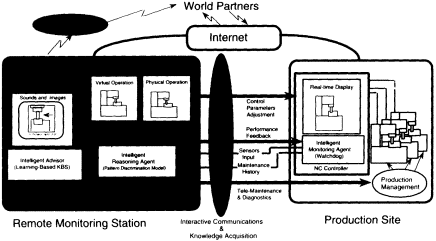
Figure 1
A typical teleservice engineering system. Source: Lee, 1996a.
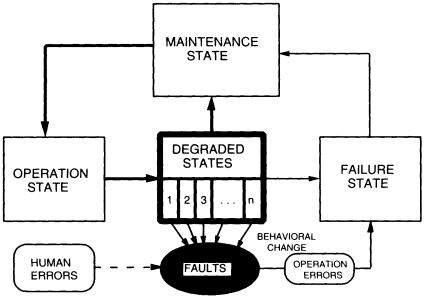
Figure 2
Machine's performance states. Source: Lee, 1992.
level, a component is described as degraded whenever a deterioration occurs but does not cause loss of its function. For example, component degradation occurs whenever corrective maintenance is required, such as a loose belt, a worn brush of a motor, or dust on a photosensor, but the components have not failed. Detailed degradation is associated with a given range of characteristics of the components, or performance of the components, such as detailed degraded states for a car battery indicator and temperature indicator. The advantage of defining more detailed degradation states is that we can accurately predict impacts on the failure of a component. When aging occurs, the component and machine generally progress through a series of degradation states before failure occurs. If a degradation condition can be measured and detected, proactive corrective maintenance activities can be performed before further degradation or failure occurs.
To effectively measure the degradation of a machine, its behavior and associated information from operators and its working environment need to be assessed adaptively. A watchdog agent, a neural computing algorithm, has been developed by the author to provide on-line composition and reasoning. In addition, this agent could be connected with a telephone jack so that machine behavior and its performance information could be accessed and evaluated from a remote site. The watchdog agent and its working principles are shown in Figure 3.
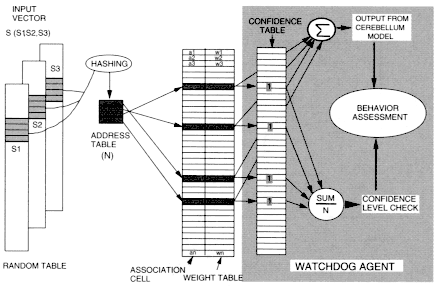
Figure 3
Watchdog agent for machine behavior assessment. SOURCE: Lee, 1992.
Briefly speaking, the watchdog agent can be described as a computing device that accepts an input vector S = (S1, S2, . . ., Sn) and produces an output vector P = F(S). To compute the output vector P for a given input state S, pair mapping is performed, namely
![]()
where A is called the association cell vector, which is actually a large table of memory addresses. Given an input vector S = (S1, S2, S3,. . ., Sn), the mapping function f points to some memory addresses (location in the A table); these locations are among the association cells A and are referred to as the active association cells. The number of active association cells for any given input is a fixed parameter of the watchdog module selected by the user. Weight(s), or tabulated values that contribute to the output response, are attached to each association cell. One weight if output vector P is one dimensional, and n weights if P is n dimensional, is attached to each cell. Mapping function g uses the weights associated with the active association cells and generates an output response. Function g may be a simple summation if the weights are attached to active association cells, or it may vary during the training and storage process. Any
input vector is therefore a set of address pointers, and the output vector, in its simplest form, is the sum of weights attached to these address pointers. Thus, each element of the output P = (p1, p2, . ., Pn) is computed by a separate watchdog from the formula
p(k) = a1(k) × w1(k) + a2(k) × w2(k) + . . . + an(k) × wn(k)
where A(k) = (a1(k), a2(k), . . ., an(k)) is the association cell vector of the kth watchdog and W(k) = (w1(k), w2(k), . . ., wn(k)) is the weight vector of the kth watchdog. The value of the output for a given input can be changed by changing the weights attached to the active association cells.
A procedure for entering a function in a watchdog agent is as follows:
- Assume F is the function we want the watchdog agent to compute. Then P = F(S) is the desired value of the output vector of each point in the input space.
- Select a point S in input space where P is to be stored. Compare the current value of the function at that point P* = F(S).
- For every element in P = (p1, p2, . . ., pn) and P* = (p*1, p*2 ,. . ., p*n), if l pI - p*i l < ei, where ei is an acceptable error, do nothing; the desired value is already stored. However, if l pI - p*i l > ei, add to every weight that contributed to p* the quantity Mi = (pI - p*i) / N, where N is the number of weights that contributed to p*i.
The values of a set of inputs act as pointers to a table of random numbers. These numbers are hashed to form a set of addresses in a weight table. The values in the weight table pointed to by these addresses are summed to yield an output. Training consists of adjusting the values in the weight table based on the error between their present summation value and the desired output for the particular values of the input that resulted in these addresses.
Knowledge Learning and System Failure Recovery Agent. Knowledge-intensive intelligent tools are required for the acquisition and organization of data in a machine and its working environment to track the behavior of the machine at any given time. A watchdog chip will serve as the blackbox of a machine and is able to keep the signatures of major components. In case of failure, operators can access the blackbox and obtain the last several minutes of information about the behavior of the machine. As a result, faults can be located quickly, and the system can be recovered rapidly. Knowledge-based information can also be shared with other user sites.
Digital Service Technologies for Collaborative Maintenance. Multimedia-based tools are required to support remote users for maintenance assistance. Interactive and collaborative tools will enable technical personnel to perform
diagnostics from a remote distance. Digital maintenance diagnostics and maintenance tools such as a smart helmet with integrated media will improve the effectiveness of the production equipment through collaborative maintenance and diagnostics. A smart glove would enable operators to perform machine maintenance and performance adjustment collaboratively.
Research Issues and Opportunities in Digital Service Technology
To achieve the digital service enterprise in today's globalized manufacturing industries, issues and technical challenges need to be addressed. The fundamental research issue that prevents us from resolving these problems is an inadequate understanding of the behavior of manufacturing machines and equipment on a daily basis. We simply do not know how to measure the performance degradation of components and machines. We lack validated predictive models that could tell us what would happen when the process parameters take on specified values. The research challenge, therefore, will be to construct models and agents that can be used to assess a machine's behavior remotely. These models must be interoperable and responsive to agents, so that remote users do not always have to communicate with them through a human intermediary.
Some research challenges and opportunities in selected technical areas have been discussed by Goncharenko et al., (1997) and Shi et al., (1997). Below is a summary of these challenges and research opportunities:
- Sensing System Standardization. In-process sensing and in-machine sensing are the foundation for teleservice systems. Because of the complexity of a machine and its associated environment, different types of sensors may be used, requiring different data acquisition protocols and systems. As teleservice practice expands, more machines/processes will be linked within the remote diagnosis system. Standards should include the selection of sensor type for typical signals, sensor signal output ranges, protocols, and so forth. There are several industry standards currently available. Research efforts are needed to develop synthesis tools for sensory system design and implementation.
- Adaptive Sensor Fusion and Affordability. One physical machine fault (e.g., an unbalanced shaft) may generate different symptoms (e.g., vibration, temperature changes, motor load variation) and can be measured by different sensors (e.g., an accelerometer, thermal couples, motor current). Similarly, one sensor may sense different types of machine faults that are occurring simultaneously, and the sensor's sensitivity may vary as the operating condition changes. Thus, adaptive sensor fusion, which will improve the reliability of the diagnosis, should be emphasized. However, affordability should also be emphasized. Issues of affordability will lead to cheaper sensing techniques, fewer demands on sensing data accuracy, and high requirements on the noise rejection capability of the
- algorithms. In addition, optimal objective-oriented sensor placement strategy needs to be investigated. Remote diagnosis provides a better opportunity to develop the aforementioned techniques by implementing knowledge, experience-sharing, and self-learning.
- Data Compression, Features Extraction, and Task Allocation. Sensing data will be transferred to a central server through the Internet. If transferring the raw data directly, long time delays due to heavy traffic may be experienced. In addition, more storage space may be required in the central server. One area that needs to be addressed is data preprocessing for data compression and feature extraction. It should be noted that the data compression task would be different from the conventional approach in image analysis and signal processing, even though there are many similarities and some techniques can be borrowed. The research emphasis here is on how to combine the engineering knowledge and diagnosis requirements in the data compression and preprocessing stages. Engineering feature-based data compression should be developed, which considers the important features in diagnostic analysis and system performance assessment. Examples in this category include (1) identifying engineering model parameters from the data and transferring only the model coefficients to the server, (2) extracting features from the original sensing signature and adjusting the threshold based on the interested signal information, and (3) transferring data continuously to the server from low- to high-wavelet coefficients and developing stopping criteria based on the decisionmaking strategy. Task allocation is another research topic closely related to teleservice engineering systems. According to the requirements for response time to faults, the monitoring and diagnosis tasks can be classified as immediate response (e.g., tool breakage, collision), intermediate response (e.g., tool wear, temperature compensation), and slow response (e.g., machine wear and degradation, environment changes). According to the information required and the complexity involved in decisionmaking, the tasks can be classified as single-variable process change detection, multivariate analysis, and integrated decisionmaking. A study needs to be conducted to classify all tasks into various categories. As a result, the watchdog agent could perform simple on-line and real-time process change detection for tasks requiring immediate response. In the future, teleservice engineering systems should be directed toward more complex diagnostic tasks that necessitate correlated degradation assessment for multivariate data.
- Collaborative Maintenance and Diagnostics. A major advantage of implementing teleservice engineering systems is the opportunity for collaborative maintenance and diagnostics. These can be achieved through (1) fault condition data collection, in which the remote diagnostics system provides an opportunity to accumulate more machine/process fault conditions and thus a better diagnosis algorithm can be developed from the fault conditions in various remote sites, and (2) fault diagnosis, in which the information is available in the server and can be accessed by experts at various locations. Thus, knowledge distributed over var-
- ious sites can be integrated to perform more complex collaborative diagnoses. However, significant research on how to manage the information and distributed decisionmaking components is required. Such topics as distributed artificial intelligence, competitive decisionmaking, and risk management should be researched in th diagnosis.
- Self-learning and Supervised Learning for Smart Service Agents. Even though the topics of supervised learning and self-learning have been studied by various researchers, they become more critical in a remote diagnosis environment. Because of the nature of remote diagnosis, process data from many different locations c is more critical. Furthermore, it is anticipated that fewer well-trained supervisors may perform the task due to the availability of new information. Another challenge is how to assess new information before using it for the purpose of learning. The information assessment stage can be integrated as part of the supervised/self-learning research.
- Integrated Performance Assessment. The teleservice system will provide several categories of information together, such as on-line process/machine sensing data, historical fault/degradation data, and machine design information. All information should be integrated when conducting a performance evaluation. The author has proposed the concept of machine physiology, which focuses on behavior-based computation rather than model-based computation for machine performance degradation assessment without using machine fault condition information. In addition, knowledge of machine performance can be learned and modeled and eventually used in machine performance compensation. Thus, the performance of a typical machine may not necessarily degrade over time but instead be improved by using learning-modeling-compensation techniques.
- Self-maintenance and Dependability. A backup strategy should be considered for overall system reliability improvement and for determining what to do if the Internet system malfunctions. Under various conditions, the system should be able to operate and perform basic functions, albeit with deteriorated performance. For example, if the Internet is not available for data transfer and remote diagnosis, local data processing should be executed to conduct essential tasks that are nominally carried at the remote site. How to design a redundant system with minimum cost and high performance is a challenge. This is also related to task allocation and analysis, simplified diagnosis algorithms, and decisionmaking under incomplete information.
- Reconfigurablity and Transferability. The remote system is a complex system involving intensive hardware and software development. The systems developed for different applications should share common modules. Furthermore, computer/Internet technology and diagnosis methodologies are advancing rapidly, and the developed system should be able to incorporate advancements
- easily without major modifications. Thus, reconfigurability and transferability are important in all aspects of system development.
Conclusion
Tomorrow's manufacturing industries must cope with the life-cycle support of the products they produce in a globalized enterprise. Information technology will play an indispensable role in supporting and enabling the complex practices of design and manufacturing by providing the mechanisms to facilitate and manage the integrated system discipline. The need for improved understanding of a product's performance for after-market service will lead to digital service technology for reasons other than troubleshooting. Manufacturers and users will benefit from the increased equipment and process reliability that digital service technology offers. In addition, manufacturing suppliers will benefit from the opportunity to sell process solutions, not just equipment, to their customers.
References
Goncharenko, I., K. Mori, and J. Lee. 1997. Real-time monitoring of machining processes via the internet: VR modeling approach. Proceedings of the International Conference on Manufacturing Milestones toward the 21st Century. Tokyo: Japan Society of Mechanical Engineers.
Lee, J. 1992. In-Process Machine Degradation Monitoring and Fault Detection Using a Neural Networks Approach. Ph.D. dissertation. Washington, D.C.: George Washington University.
Lee, J. 1995a. Machine performance monitoring and proactive maintenance in computer integrated manufacturing: Review and perspective. International Journal for Computer Integrated Manufacturing 8(5):370-380.
Lee, J. 1995b. Modern computer-aided maintenance of manufacturing equipment and systems: Review and perspective. Computers and Industrial Engineering 28(4):793-811.
Lee, J. 1996a. Manufacturing Study in Japan. NSF Report. Arlington, Va.: National Science Foundation.
Lee, J. 1996b. Measurement of machine performance degradation using a neural networks model. Computers in Industry 30(3): 193-209.
Lee, J. 1996c. Strategy on globalization support remote manufacturing system. Paper presented at the International Conference on Advances in Production Management Systems (APMS '96), Kyoto, Japan, November 4-6, 1996.
Lee, J., and B. M. Kramer. 1993. Analysis of machine degradation using a neural network based pattern discrimination model. Journal of Manufacturing Systems 12(5):379-387.
National Research Council. 1995. Information Technology for Manufacturing: A Research Agenda. Computer Science and Telecommunications Board and Manufacturing Studies Board. Washington, D.C.: National Academy Press.
Shi, J., J. Ni, and J. Lee. 1997. Research challenges and opportunities in remote diagnostics and system performance assessment. Intelligent Manufacturing Systems (IMS '97): A Proceedings Volume from the 4th IFAC Workshop, J. Kim, ed. New York: Pergamon.
| This page in the original is blank. |






















